
Thomas Ustick Walter was an American architect of German descent, the dean of American architecture between the 1820 death of Benjamin Latrobe and the emergence of H.H. Richardson in the 1870s. He was the fourth Architect of the Capitol and responsible for adding the north (Senate) and south (House) wings and the central dome that is predominantly the current appearance of the U.S. Capitol building. Walter was one of the founders and second president of the American Institute of Architects. In 1839, he was elected as a member to the American Philosophical Society.

The Tennessee State Capitol, located in Nashville, Tennessee, is the seat of government for the U.S. state of Tennessee. It serves as the home of both houses of the Tennessee General Assembly–the Tennessee House of Representatives and the Tennessee Senate–and also contains the governor's office. Designed by architect William Strickland (1788–1854) of Philadelphia and Nashville, it was built between 1845 and 1859 and is one of Nashville's most prominent examples of Greek Revival architecture. The building, one of 12 state capitols that does not have a dome, was added to the National Register of Historic Places in 1970 and named a National Historic Landmark in 1971. The tomb of James K. Polk, the 11th president of the United States, is on the capitol grounds.
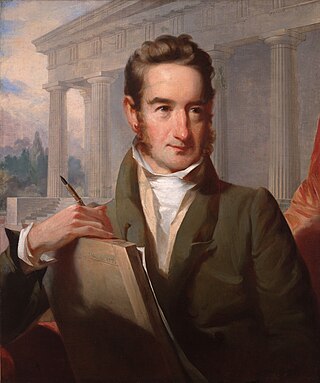
William Strickland was a noted architect and civil engineer in Philadelphia, Pennsylvania, and Nashville, Tennessee. A student of Benjamin Latrobe and mentor to Thomas Ustick Walter, Strickland helped establish the Greek Revival movement in the United States. A pioneering engineer, he wrote a seminal book on railroad construction, helped build several early American railroads, and designed the first ocean breakwater in the Western Hemisphere. He was elected as a member of the American Philosophical Society in 1820.
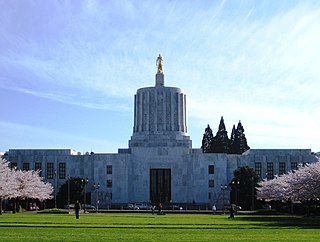
The Oregon State Capitol is the building housing the state legislature and the offices of the governor, secretary of state, and treasurer of the U.S. state of Oregon. It is located in the state capital, Salem. Constructed from 1936 to 1938 and expanded in 1977, the current building is the third to house the Oregon state government in Salem. The first two capitols in Salem were destroyed by fire, one in 1855 and the other in 1935.

Trowbridge & Livingston was an architecture firm based in New York City, active from 1897 to 1925. The firm's partners were Breck Trowbridge and Goodhue Livingston. They were successors to the firm Trowbridge, Colt & Livingston, founded in 1894 but dissolved in 1897 when Stockton B. Colt left the partnership.

Sequoyah Hills is a neighborhood in Knoxville, Tennessee, United States, named for the Cherokee scholar Sequoyah. It is located off Kingston Pike, between the city's downtown and West Knoxville. Initially developed in the 1920s, Sequoyah Hills was one of Knoxville's first suburbs and today is home to some of the city's most affluent residents. The neighborhood contains numerous notable examples of mid-20th century residential architecture, with houses designed by architects such as Charles I. Barber, Benjamin McMurry, and Francis Keally.

Goodhue Livingston was an American architect who co-founded the firm of Trowbridge & Livingston. He designed the St. Regis Hotel, the Hayden Planetarium, and numerous buildings listed on the National Register of Historic Places.

Old Fort Harrod State Park is a park located in Harrodsburg, Kentucky in the United States. The park encompasses 15 acres (6.1 ha) and features a reconstruction of Fort Harrod, the first permanent American settlement in the state of Kentucky. The park was founded in November 1934 as Pioneer Memorial State Park, and dedicated by President Franklin D. Roosevelt and Governor Ruby Laffoon.

Ulric Henry Ellerhusen (1879–1957) first name variously cited as Ulrich or Ulrik, surname sometimes cited as Ellerhousen) was a German-American sculptor and teacher best known for his architectural sculpture.
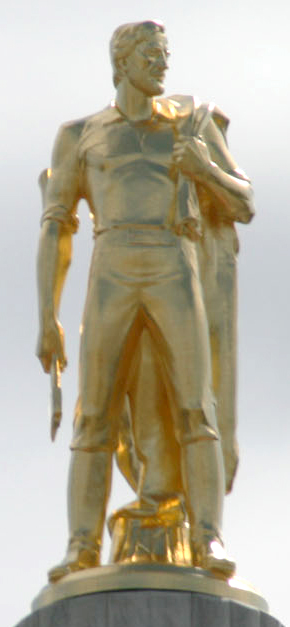
Oregon Pioneer, also known as Gold Man, is an eight-and-a-half ton bronze sculpture with gold leaf finish that sits atop the Oregon State Capitol in Salem, Oregon, United States. Created by Ulric Ellerhusen, the statue is a 22 ft (7 m)-tall hollow sculpture. The gilded piece was installed atop the building in 1938 when a new capitol was built.
This is an incomplete list of historic properties and districts at United States colleges and universities that are listed on the National Register of Historic Places (NRHP). This includes National Historic Landmarks (NHLs) and other National Register of Historic Places listings. It includes listings at current and former educational institutions.
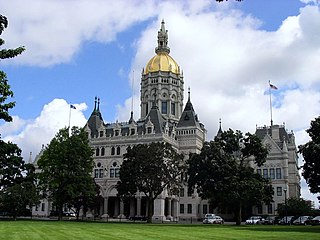
Richard Michell Upjohn, FAIA, was an American architect, co-founder and president of the American Institute of Architects.

Tennessee marble is a type of crystalline limestone found only in East Tennessee, in the southeastern United States. Long esteemed by architects and builders for its pinkish-gray color and the ease with which it is polished, this stone has been used in the construction of numerous notable buildings and monuments throughout the United States and Canada, including the National Gallery of Art and the National Air and Space Museum in Washington, D.C., the Minnesota State Capitol, as well as parts of the United States Capitol in Washington, Grand Central Terminal in New York, and Union Station in Toronto. Tennessee marble achieved such popularity in the late-19th century that Knoxville, the stone's primary finishing and distribution center, became known as "The Marble City."
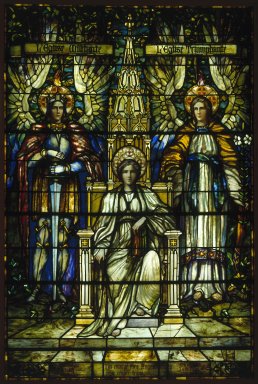
J&R Lamb Studios, America's oldest continuously-run decorative arts company, is famous as a stained glass maker, preceding the studios of both John LaFarge and Louis C. Tiffany.

Raymond F. Almirall (1869–1939) was an American architect of the Beaux-Arts period, practicing in New York City.
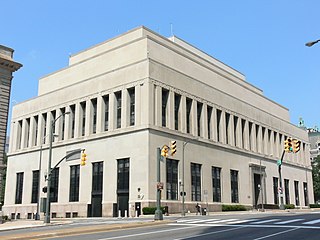
The Patrick Henry Building is a historic building located in Richmond, Virginia. Formerly designated simply as the Old State Library or the Virginia State Library and Archives and Virginia Supreme Court, it was renovated, then rededicated and renamed for the Founding Father and former Virginia Governor Patrick Henry on June 13, 2005.
Edward De Peyster Livingston was an American lawyer and society leader during the Gilded Age.
Iwahiko Tsumanuma, a.k.a. Thomas S. Rockrise, A.I.A., was one of the earliest Japanese immigrants to receive an architecture degree at an American university and was among the first Japanese architects to be licensed in the State of New York in 1916. His practice was based in New York City and included work in the United States as well as Asia.
Stockton Beekman Colt was an American architect noted for using the Renaissance style. A graduate of Columbia University, Colt apprenticed with George B. Post in New York City. In 1894, he was a founding partner in Trowbridge, Colt & Livingston with Goodhue Livingston and Samuel Beck Parkman Trowbridge.
Alfred Morton Githens (1876–1973) was an American architect particularly known for his work designing library buildings.
















